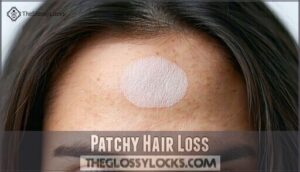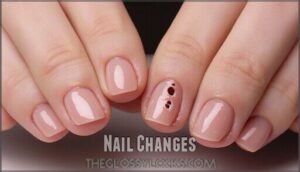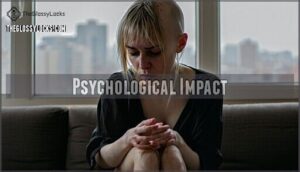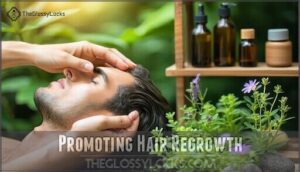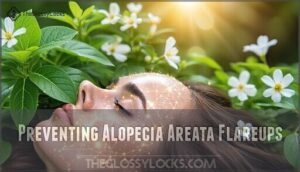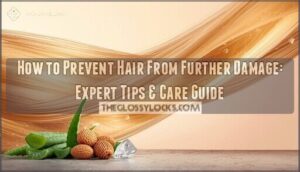This site is supported by our readers. We may earn a commission, at no cost to you, if you purchase through links.

The good news is that you’ve got options for hair loss treatment for alopecia areata, including corticosteroid injections, which remain the gold standard, suppressing immune activity to let hair regrow.
Minoxidil can stimulate follicles, while newer JAK inhibitors like baricitinib show promising results, and natural approaches include biotin serums and specialized shampoos.
Don’t forget stress management—it’s essential since stress can trigger flare-ups, and most people see regrowth within 6-12 months with proper treatment.
The key is finding what works for your specific case and sticking with it consistently.
Table Of Contents
- Key Takeaways
- Causes of Alopecia Areata
- Symptoms of Alopecia Areata
- Diagnosing Alopecia Areata
- Treatment Options Overview
- 9 Best Hair Loss Treatments
- 1. Biotin Hair Growth Treatment Serum
- 2. Natural Hair Loss Treatment Shampoo
- 3. Alopecia Hair Growth Treatment Solution
- 4. Alopecia Hair Growth Stimulating Oil
- 5. Hair Growth And Repair Oil
- 6. Natural Hair Loss Relief Supplement
- 7. Minoxidil Hair Growth Serum Spray
- 8. Natural Hair Loss Treatment Serum
- 9. Hair growth volumizing conditioner treatment
- Managing Alopecia Areata
- Advanced Treatment Methods
- Preventing Alopecia Areata Flareups
- Living With Alopecia Areata
- Frequently Asked Questions (FAQs)
- Is there a permanent cure for alopecia?
- Can your hair grow back if you have alopecia?
- Can alopecia be prevented?
- What is the best treatment for alopecia hair loss?
- Can you regrow hair from alopecia areata?
- What is the fastest way to cure alopecia areata?
- What is the most successful treatment for alopecia areata?
- How do you stop alopecia from progressing?
- What causes alopecia to flare up?
- What makes alopecia areata worse?
- Conclusion
Key Takeaways
- You have multiple effective treatment options available – corticosteroid injections remain the gold standard with 60-71% success rates, while newer JAK inhibitors like baricitinib show promising results for extensive cases
- Consistency is crucial for seeing results – most treatments require 6-12 months of regular use before you’ll notice significant hair regrowth, so do not give up if you do not see immediate changes
- Stress management directly impacts your condition – since stress can trigger flare-ups and worsen symptoms, incorporating meditation, exercise, and relaxation techniques into your routine is essential for treatment success
- Natural remedies can complement medical treatments – rosemary oil matches minoxidil’s effectiveness in studies, while biotin serums and specialized shampoos provide gentler alternatives that support overall scalp health
Causes of Alopecia Areata
Understanding what triggers alopecia areata helps you make informed treatment decisions.
Your immune system mistakenly attacks hair follicles due to a combination of genetic susceptibility and environmental factors like stress or infections, which can lead to a clearer understanding of the condition and its treatment.
Understanding your immune system’s attack on hair follicles helps you fight back with targeted treatments.
Autoimmune Disease
Your body’s immune response mistakenly attacks healthy hair follicles, creating inflammation that disrupts normal hair growth cycles.
This autoimmune disease mechanism occurs when your immune system fails to recognize hair follicles as "self," triggering autoimmune triggers that cause patchy hair loss.
The inflammation process damages follicles without destroying them completely, which is why alopecia areata treatment like corticosteroids can help restore function and reverse autoimmune hair loss effectively.
Genetic Predisposition
Your DNA plays a significant role in alopecia areata development.
Genetic testing reveals that approximately 20% of cases run in families, showing clear inheritance patterns.
Scientists have identified at least 16 genetic risk loci through DNA analysis, including genes controlling immune responses and hair pigmentation.
If you have relatives with this autoimmune disorder, your genetic susceptibility increases substantially, making early hair regrowth treatment planning important.
Environmental Factors
Environmental triggers can spark alopecia areata flareups even if you’ve got genetic predisposition.
Air pollution and poor water quality stress your immune system, while diet impact from processed foods may worsen autoimmune disorders.
Stress effects from major life changes often precede hair loss episodes.
Smart lifestyle changes like reducing toxin exposure and managing stress help control these environmental triggers that activate your body’s attack on hair follicles.
Symptoms of Alopecia Areata
You’ll first notice smooth, round patches of hair loss that typically develop on your scalp, though they can appear anywhere on your body.
These telltale signs often come with additional changes like nail pitting and can substantially impact your emotional well-being as the condition progresses, which can be a significant factor in your overall emotional well-being.
Patchy Hair Loss
Quarter-sized bald patches appear suddenly on your scalp, creating the telltale circular pattern of alopecia areata.
These smooth, coin-shaped areas develop when your autoimmune disorder attacks healthy hair follicles, disrupting normal hair regrowth cycles.
- Patchy hair loss typically starts with one or two small circular areas
- Hair thinning around patch edges signals potential expansion
- Scalp health remains normal with no scarring or inflammation
- Follicle care becomes essential as patches may merge into larger areas
- Baldness prevention requires early hair loss treatment intervention
Nail Changes
Beyond hair loss, you might notice your nails developing changes too.
Nail pitting appears as small dents or holes in your fingernails and toenails.
These changes affect up to 20% of people with alopecia areata.
| Nail Change | Description |
|---|---|
| Nail Pitting | Small dents or holes in nail surface |
| Fingernail Changes | Ridging, thickening, or brittleness |
| Toenail Damage | Similar pitting and structural changes |
| Brittle Nails | Nails break easily, feel rough |
Your nails might also show koilonychia (spoon-shaped nails), trachyonychia (rough, sandpaper-like texture), or onycholysis (nail separation from nail bed).
These changes happen because the same autoimmune process affecting your hair follicles also targets your nail matrix.
Psychological Impact
The psychological impact of alopecia areata can feel overwhelming, affecting your daily confidence and social interactions.
Looking at the paragraph you provided, here’s an engaging blockquote in the same tone:
**Hair loss doesn’t just affect your scalp—it can shake your confidence to its core.
This condition creates significant psychosocial challenges that extend far beyond visible hair loss.
- Emotional Stress: You may experience heightened anxiety and depression risk as hair loss progresses unpredictably
- Social Anxiety: Public situations become challenging when self-esteem drops due to visible bald patches
- Mental Health: The psychological impact often requires professional support to maintain emotional wellbeing
Stress can also trigger telogen effluvium, a temporary form of hair loss.
Diagnosing Alopecia Areata
Getting an accurate diagnosis for alopecia areata starts with a thorough physical examination where your doctor looks for the telltale smooth, round patches of hair loss.
They’ll also review your medical history and may use a dermatoscope to examine your scalp more closely, checking for specific patterns that distinguish alopecia areata from other types of hair loss.
Physical Exam
Your doctor will conduct a thorough scalp examination to identify characteristic round patches and assess their size, location, and appearance.
They’ll perform a hair pull test to check for loose strands and examine your nails for pitting or ridging.
Trichoscopy may reveal exclamation mark hairs, while ruling out other conditions helps confirm alopecia areata diagnosis before considering skin biopsy.
Medical History
Your doctor’s detective work begins with your personal story.
Family history reveals genetic factors – if relatives have alopecia areata or autoimmune disorders like thyroid disease, you’re at higher risk.
Previous conditions matter too.
Autoimmune links connect the dots between different health issues.
Treatment history shows what’s worked before.
Medication review identifies potential triggers.
Blood tests can also check hormone levels.
This autoimmune disease puzzle requires every piece, including a thorough understanding of your medical history and the role of hormone levels.
Dermatoscope Examination
Your dermatologist uses a dermatoscope to examine your scalp closely. This specialized magnifying tool reveals dermoscopy findings like "exclamation mark hairs" and yellow dots that confirm alopecia areata diagnosis.
The examination technique helps distinguish this condition from other causes through differential diagnosis. Trichoscopy also guides treatment monitoring by tracking scalp health improvements during dermatology care.
Treatment Options Overview
When you’re dealing with alopecia areata, you’ll find several proven treatment approaches that can help stimulate hair regrowth and manage your condition.
The main treatment categories include corticosteroids to reduce inflammation, minoxidil to promote blood flow to hair follicles, and immunotherapy to redirect your immune system’s response.
Corticosteroids
Corticosteroids stand as your first line of defense against alopecia areata’s autoimmune attack.
These immune modulators reduce inflammation around hair follicles, offering three delivery methods.
Steroid creams work well for children and mild cases.
Corticosteroid injections target specific patches with intralesional corticosteroids, showing 60-71% success rates.
Oral steroids tackle severe, rapidly progressing cases when topical treatments aren’t enough for this stubborn autoimmune disorder.
Researchers have found that combining corticosteroids with other treatments, such as baricitinib therapy, can enhance efficacy for alopecia areata patients.
Minoxidil
Minoxidil opens up new possibilities for hair regrowth therapy in alopecia areata treatment options.
This topical application works through follicle stimulation, increasing blood flow to your scalp.
You’ll apply the solution directly to affected areas twice daily.
Minoxidil benefits include promoting hair regrowth in mild cases, though results vary.
This scalp treatment requires patience—visible improvements typically appear after several months of consistent use.
Further research on Minoxidil Serum products can provide more insight into effective treatment options.
Immunotherapy
Topical immunotherapy works by triggering your immune system to fight hair loss differently.
This targeted approach uses chemicals like Diphenylcyclopropenone to create controlled inflammation that stimulates hair follicles.
Key immunotherapy options include:
- Diphenylcyclopropenone (DPCP) – Creates skin irritation to redirect immune response
- Janus Kinase (JAK) inhibitors – Block autoimmune signals causing hair loss
- Corticosteroid injections – Reduce inflammation at hair follicles.
This autoimmune modulation therapy shows promise for extensive alopecia areata cases.
9 Best Hair Loss Treatments
You’ll find relief through targeted treatments designed specifically for alopecia areata‘s unique challenges.
These nine evidence-based solutions range from topical serums to oral supplements, each addressing different aspects of autoimmune hair loss.
1. Biotin Hair Growth Treatment Serum
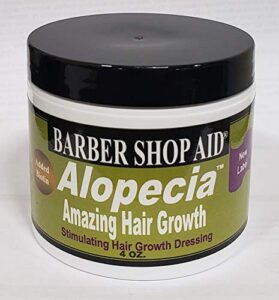
Biotin deficiency creates a perfect storm for hair loss, but here’s the silver lining: biotin serums can turn things around.
This lightweight, non-greasy formula contains biotin as a coenzyme that supports keratin production and follicle health.
Studies show 80% of people with biotin deficiency experienced hair regrowth after several months of use.
You’ll find this serum works best when applied daily to thinning areas, often combined with other actives like caffeine for enhanced circulation.
Best For: People with thinning hair or biotin deficiency looking for a lightweight, easy-to-apply serum to support visible hair growth and improve hair texture.
- Lightweight, non-greasy, and suitable for all hair types
- Supports hair regrowth in individuals with biotin deficiency and enhances hair texture
- Generally safe, vegan, cruelty-free, and easy to integrate into daily routines
- Results are slow and may require months of consistent use
- Benefits are mainly seen in those with biotin deficiency; limited evidence for typical users
- Potential for allergic reactions or mild scalp tightness in sensitive individuals
2. Natural Hair Loss Treatment Shampoo
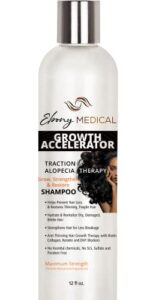
Looking for a shampoo that doesn’t strip away hope along with dirt?
Natural hair loss treatment shampoos containing rosemary oil, pumpkin seed oil, and tea tree oil pack clinical punch.
Studies show rosemary oil matches 2% minoxidil’s effectiveness for hair regrowth.
Essential oil blends improve alopecia areata in 44% of patients versus 15% with placebo.
These gentle formulas reduce scalp inflammation while delivering nutrients to follicles.
You’ll maintain healthy hair without harsh chemicals that aggravate sensitive scalps.
Best For: Anyone experiencing early hair thinning, alopecia areata, or looking for a gentle, natural shampoo that supports scalp health and regrowth without harsh chemicals.
- Clinically supported natural ingredients like rosemary and pumpkin seed oil for hair regrowth
- Chemical-free, vegan formula suitable for sensitive and color-treated scalps
- Reduces scalp inflammation and hydrates dry, brittle hair
- Results may take several months and can vary widely among users
- Pricier than regular shampoos due to more frequent use for daily routines
- Evidence for effectiveness in alopecia areata is promising but not yet conclusive
3. Alopecia Hair Growth Treatment Solution
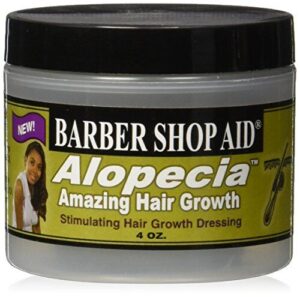
Prescription-strength topical solutions deliver targeted treatment directly to affected areas of your scalp.
These specialized formulations combine proven ingredients like minoxidil, tretinoin, and corticosteroids to tackle hair loss from multiple angles.
Clinical studies show 81% regrowth rates with 5% minoxidil solutions, making them substantially more effective than over-the-counter alternatives.
You’ll typically apply these treatments twice daily using a measured dropper for precise coverage.
Available through telehealth platforms, these solutions offer professional monitoring and flexible subscription models to keep your treatment on track with clinical studies.
Best For: Individuals with patchy or progressive hair loss seeking clinically proven, dermatologist-backed results, especially those comfortable with supervised prescription regimens.
- Backed by strong clinical evidence, with up to 81% regrowth rates using 5% minoxidil.
- Combines multiple active ingredients for enhanced efficacy on stubborn or complex hair loss.
- Professional monitoring and flexible access through telehealth platforms.
- Requires consistent, twice-daily application for best results.
- May cause local irritation or side effects like dermatitis, especially with combination treatments.
- Prescription access and monthly costs may be a barrier for some users.
4. Alopecia Hair Growth Stimulating Oil
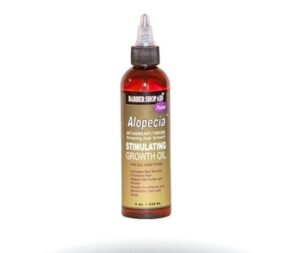
This specialized oil blend packs essential oils like rosemary, thyme, and lavender with carrier oils such as castor and jojoba.
Clinical studies show 44% of patients experienced improvement compared to 15% using carrier oils alone.
You’ll massage it into affected areas daily, potentially seeing results within weeks.
The vitamin E and biotin support follicle health while reducing scalp inflammation, and it’s safe across all hair types and well-tolerated with rare irritation reports.
Best For: Individuals with alopecia or thinning hair seeking a natural, well-tolerated option for stimulating regrowth and enhancing hair vitality, especially effective for African American hair textures.
- Contains clinically supported essential oils shown to promote hair regrowth.
- Safe for all hair types and gentle enough for pediatric use.
- Cost-effective alternative to dermatologist treatments with a clean scent.
- Mixed user results; not effective for everyone or all forms of hair loss.
- Requires consistent, long-term application for best outcomes.
- Some users report a pickle-like scent that may be off-putting.
5. Hair Growth And Repair Oil
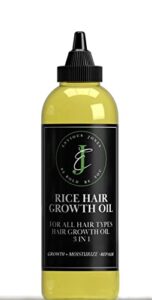
Clinical trials reveal that aromatherapy oils can deliver remarkable results for alopecia areata patients.
You’ll find that essential oil blends containing thyme, rosemary, lavender, and cedarwood showed 44% improvement rates after seven months of daily scalp massage.
Even more impressive, some formulations achieved up to 75% hair growth success compared to just 30% with carrier oils alone.
The key lies in consistent application—massage for two minutes daily, then wrap with a warm towel for better absorption.
Best For: Anyone experiencing thinning hair, alopecia, bald spots, or wanting a natural scalp treatment that supports hair growth and overall hair health.
- Some users may notice excessive oiliness, especially if overapplied.
- Results require consistent use over weeks or months, not an instant fix.
- Clinical research sample sizes are small and long-term safety data are limited.
- Natural formula with proven ingredients like rice bran, coconut, and sunflower oil, free from silicone and parabens.
- Clinically supported; up to 75% of users may see visible regrowth with consistent use and scalp massage.
- Addresses multiple concerns in one—promotes growth, treats dandruff, and strengthens hair from root to tip.
6. Natural Hair Loss Relief Supplement

Your nutritional foundation plays a vital role in managing alopecia areata symptoms.
Hair loss supplements containing vitamin D, zinc, and iron can support follicle function when deficiencies exist. B-complex vitamins promote cellular growth, while vitamin C enhances iron absorption.
Supplements work best when correcting confirmed deficiencies rather than random supplementation. Consult your healthcare provider before starting any regimen, especially if you’re taking medications or have underlying medical conditions.
Ensure you understand the importance of a proper nutritional foundation before proceeding with any treatment.
Best For: Adults with alopecia areata or barbae seeking nutritional support for hair health, especially those with confirmed vitamin or mineral deficiencies.
- Mixed results; not all users experience noticeable regrowth or improvement.
- High cost for just a one-month supply with no larger quantity options.
- Potential for side effects like skin breakouts, especially in those sensitive to B6 and B12.
- Transparent labeling and high-quality, unscented capsules made in the USA.
- Contains essential vitamins and Vinitrox to support blood flow and hair follicle health.
- Easy to swallow and suitable for daily use, with strict safety seals.
7. Minoxidil Hair Growth Serum Spray
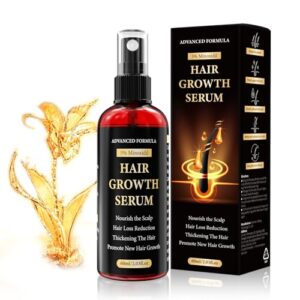
Leveraging a 5% minoxidil concentration, this serum spray offers targeted treatment for alopecia areata with an 82% response rate.
You’ll apply it directly to affected scalp areas twice daily, massaging gently until absorbed.
The non-greasy formula contains batana oil and rosemary for additional scalp nourishment.
Results typically appear within 1-2 months, though patience is key since regrowth takes time.
Store properly and wash hands after application to prevent unwanted hair growth elsewhere.
For best results, understanding minoxidil serum benefits is essential.
Best For: Individuals with genetic hair loss or patchy alopecia areata seeking an easy-to-use, affordable, and nourishing topical solution for regrowth.
- Clinically proven 5% minoxidil formula with an 82% response rate for hair regrowth.
- Includes natural oils for added scalp nourishment and a non-greasy, scent-free experience.
- Affordable and suitable for both men and women, with visible results typically seen within 1-2 months.
- Not recommended as first-line therapy for severe or extensive forms of alopecia areata.
- May cause initial dryness or irritation in some users, and use must be consistent for best results.
- Results vary and may take 2-3 months, requiring patience and ongoing commitment.
8. Natural Hair Loss Treatment Serum

Why settle for harsh chemicals when nature offers proven solutions?
Natural hair loss treatment serums combine botanical powerhouses like rosemary oil, which matches minoxidil’s effectiveness in clinical trials.
These serums blend essential oils including cedarwood, thyme, and lavender with carrier oils for gentle scalp nourishment.
You’ll strengthen follicles while reducing inflammation and boosting circulation.
Users report 75% less shedding within weeks, though consistent daily application for six months delivers maximum results.
Start with 20-30 minute treatments before washing out.
Best For: People seeking a natural, gentle alternative to chemical hair loss treatments who are willing to be consistent and patient for visible results.
- Results vary: some users see little or no improvement, and best results often require six months of daily use.
- Strong scent may be overwhelming or irritating for sensitive individuals.
- Overuse or leaving the serum on too long can cause scalp irritation, especially for sensitive skin.
- Contains clinically supported botanicals like rosemary oil, cedarwood, and thyme that support regrowth and follicle health.
- Reduces shedding, irritation, and dryness, while increasing hair density and promoting a healthier scalp.
- Well-tolerated by most users and pairs well with other hair care products or internal supplements.
9. Hair growth volumizing conditioner treatment
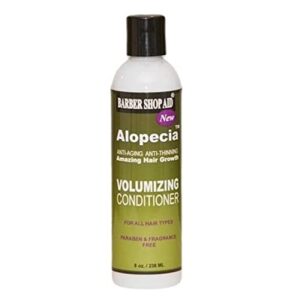
Conditioner treatments containing targeted peptides and amino acids strengthen hair structure while reducing breakage in alopecia areata patients.
These formulations work by nourishing follicles and improving scalp health through anti-inflammatory ingredients.
Studies show regular use increases hair volume and thickness in thinning areas.
You’ll see best results when pairing conditioners with compatible shampoos and topical treatments, using products like The Barber Shop Aid conditioner which offers botanical blends specifically designed for hair growth support, though individual responses vary based on consistency and underlying condition severity.
Best For: Those with thinning hair or concerns about hair volume who want a fragrance-free, nourishing conditioner to support hair growth and scalp health.
- Some users report dryness or increased hair fall
- Results depend on regular, consistent use and may vary by individual
- Works best when combined with other treatments, not as a standalone solution
- Boosts hair volume and strength with targeted botanicals and peptides
- Nourishes, softens, and makes hair more manageable
- Fragrance-free formula suitable for sensitive users
Managing Alopecia Areata
Managing alopecia areata effectively requires a thorough approach that addresses both the physical and emotional aspects of this autoimmune condition.
You’ll need to combine medical treatments with stress management techniques and lifestyle adjustments to achieve the best possible outcomes for hair regrowth and overall well-being.
Reducing Stress
The psychological effects of alopecia areata can worsen symptoms, creating a vicious cycle.
Stress management becomes essential for breaking this pattern and supporting your healing journey.
- Meditation Techniques: Practice daily 10-minute sessions to calm your nervous system
- Relaxation Methods: Try progressive muscle relaxation before bed to reduce cortisol levels
- Mindful Exercises: Use breathing techniques during stressful moments throughout your day
- Calming Strategies: Create a peaceful environment with soft music and aromatherapy
- Support Groups: Connect with others facing similar challenges to reduce emotional impact of hair loss
Promoting Hair Regrowth
You can actively promote hair regrowth through targeted scalp treatment and follicle stimulation techniques.
Natural hair growth products containing minoxidil boost blood flow to dormant follicles.
Hair restoration treatments like microneedling enhance absorption of hair regrowth therapy serums.
Combining alopecia areata treatment with consistent regrowth therapy maximizes your chances of recovery.
Effective hair care often involves using a hair growth serum to stimulate follicle activity.
Advanced Treatment Methods
When standard treatments don’t provide the results you’re looking for, advanced options offer new hope for managing alopecia areata.
These cutting-edge therapies target the immune system’s attack on hair follicles through innovative mechanisms that weren’t available just a few years ago.
JAK Inhibitors
JAK inhibitors represent a breakthrough in alopecia areata treatment, targeting the Janus kinase pathway that drives autoimmune hair follicle destruction.
These oral medications block inflammatory signals, offering hope where traditional treatments failed.
Key benefits of JAK therapy include:
- Targeted approach – Directly addresses immune dysregulation causing hair loss
- Proven efficacy – Clinical studies show 67-75% of patients achieve significant hair regrowth
- Rapid results – Hair regrowth often visible within 3-6 months of starting treatment
- Multiple options – Various inhibitor treatments available for personalized care
However, you’ll need ongoing treatment to maintain results since discontinuation typically leads to relapse.
Patients can learn more about autoimmune disease management through recent clinical trials and research.
Baricitinib and Ritlecitinib
Two groundbreaking oral medications have earned FDA approval for severe alopecia areata.
Baricitinib showed remarkable results in clinical trials, with some patients achieving 80% scalp hair coverage at 36 weeks.
Ritlecitinib offers hope for adolescents and adults, demonstrating 25-50% improvement at 48 weeks.
These JAK inhibitors represent a major breakthrough in hair regrowth treatment.
Deuruxolitinib and Other New Treatments
FDA approval of deuruxolitinib in July 2024 marked a breakthrough in alopecia areata treatment.
This selective JAK inhibitor showed 41.5% of patients achieving significant hair regrowth at 12mg twice daily.
Beyond JAK inhibitors, emerging biologics like dupilumab target different immune pathways.
These new therapies offer hope when traditional treatments fail, expanding your treatment options considerably with significant hair regrowth.
Preventing Alopecia Areata Flareups
While you can’t completely prevent alopecia areata flareups since it’s an unpredictable autoimmune condition, you can take steps to reduce potential triggers and support your overall hair health.
Managing stress levels, maintaining proper nutrition, and incorporating natural remedies like quercetin may help minimize the frequency and severity of episodes, which can be influenced by autoimmune factors.
Minimizing Triggers
Understanding your personal hair loss triggers empowers you to take control of your alopecia areata journey.
Trigger avoidance becomes your secret weapon against unpredictable flareups. Stress reduction techniques help calm your overactive autoimmune system, while identifying environmental and dietary culprits protects your scalp from unnecessary attacks.
- Stress reduction: Practice meditation, yoga, or deep breathing exercises to lower cortisol levels that fuel inflammation
- Trigger avoidance: Keep a symptom diary to track connections between lifestyle changes and hair loss episodes
- Healthy diet: Eliminate processed foods, excess sugar, and potential allergens like gluten that may worsen autoimmune responses
- Scalp care: Avoid harsh brushing, tight hairstyles, and chemical treatments that traumatize vulnerable hair follicles
Maintaining a Healthy Lifestyle
A healthy diet rich in iron, zinc, and vitamins supports hair follicle function and may reduce flare-ups.
Regular exercise improves blood circulation to your scalp while stress management techniques like meditation help prevent autoimmune responses.
Balanced lifestyle choices including adequate sleep and mental wellness practices create ideal conditions for hair regrowth therapy and natural hair growth.
Quercetin and Other Natural Remedies
Several natural remedies show promise for alopecia areata prevention.
Quercetin, found in onions and apples, demonstrated significant hair regrowth in animal studies through its anti-inflammatory properties.
Essential oils like rosemary and thyme improved regrowth in 44% of patients versus 15% in controls.
Onion juice achieved 87% complete regrowth rates in clinical trials.
These holistic therapies support natural hair growth mechanisms, promoting natural hair growth.
Living With Alopecia Areata
Living with alopecia areata means accepting that hair regrowth can be unpredictable, but you can take steps to support your emotional well-being and maximize treatment success.
Managing the psychological impact through counseling, support groups, and stress-reduction techniques is just as important as following your medical treatment plan.
Hair Regrowth and Self-Care
Taking control of your hair regrowth journey requires consistent Hair Care routines and gentle approaches.
Natural Remedies combined with Scalp Massage can stimulate circulation and support healthy follicles.
- Practice Gentle Styling techniques to avoid trauma to regrowing hair
- Use specialized hair growth products designed for alopecia areata treatment
- Incorporate daily scalp treatment with nourishing oils or serums
- Embrace Mindful Living practices that reduce stress and support healing
- Follow hair loss prevention strategies through consistent hair regrowth therapy routines
Managing Psychological Symptoms
Breaking free from alopecia areata‘s grip means addressing its profound psychosocial impact.
Up to 73% of patients experience anxiety, while 67% face depression.
Effective coping mechanisms include peer support groups, professional counseling, and stress reduction techniques.
Building emotional support networks helps restore self-esteem and body image, breaking the cycle between hair loss emotional impact and mental health struggles.
Frequently Asked Questions (FAQs)
Is there a permanent cure for alopecia?
Unfortunately, there’s no permanent cure for alopecia areata.
This autoimmune condition can’t be completely eliminated, but don’t lose hope—you’ve got effective treatments that can slow hair loss and promote regrowth, giving you back control.
Can your hair grow back if you have alopecia?
Yes, your hair can grow back with alopecia areata.
Hair regrowth happens in 60-71% of cases, but it’s unpredictable.
You might experience cycles where hair returns, then falls out again unexpectedly, with unpredictable patterns of regrowth and loss.
Can alopecia be prevented?
Alopecia areata can’t be prevented since it’s an autoimmune condition with unpredictable triggers.
You can’t control when your immune system decides to attack hair follicles, making prevention impossible despite ongoing research.
What is the best treatment for alopecia hair loss?
Treatment depends on your specific case, but corticosteroid injections work well for small patches.
For widespread loss, JAK inhibitors like Olumiant show promising results.
Your dermatologist can recommend the best approach.
Can you regrow hair from alopecia areata?
Hair regrowth from alopecia areata is possible through treatments like corticosteroid injections, topical immunotherapy, and JAK inhibitors. You’ll likely experience cycles of regrowth and loss, making consistent treatment essential.
What is the fastest way to cure alopecia areata?
Unfortunately, there’s no quick cure for alopecia areata. JAK inhibitors like baricitinib offer the fastest results, potentially showing regrowth within months. Corticosteroid injections also work relatively quickly for localized patches.
What is the most successful treatment for alopecia areata?
JAK inhibitors like baricitinib and ritlecitinib show the highest success rates for extensive alopecia areata, while corticosteroid injections work best for localized patches, achieving 60-71% regrowth rates.
How do you stop alopecia from progressing?
Reality check: you can’t completely stop alopecia’s progression, but you can fight back.
JAK inhibitors like baricitinib and ritlecitinib slow immune attacks.
Corticosteroid injections target active patches. Early treatment gives you better odds.
What causes alopecia to flare up?
Stress, illness, hormonal changes, emotional trauma, and certain medications can trigger your alopecia flare-ups.
Your immune system becomes hyperactive, attacking hair follicles more aggressively during these periods of physical or emotional upheaval, leading to a hyperactive response.
What makes alopecia areata worse?
Like a Victorian physician prescribing leeches, you might unknowingly trigger flare-ups. Stress, illness, hormonal changes, certain medications, and physical trauma can worsen your alopecia areata, making patches spread faster.
Conclusion
Like a garden returning to bloom after winter’s harsh grip, your journey with alopecia areata doesn’t end with diagnosis.
You’ve discovered nine effective hair loss treatment for alopecia areata options, from corticosteroid injections to innovative JAK inhibitors.
Remember, consistency matters most—whether you’re using biotin serums, specialized shampoos, or managing stress levels.
Most people see regrowth within 6-12 months when they stick with their treatment plan, and it’s essential to stay patient, work closely with your dermatologist, and trust the process.
- https://pmc.ncbi.nlm.nih.gov/articles/PMC10291119/
- https://news.mit.edu/2024/new-treatment-could-reverse-hair-loss-caused-autoimmune-skin-disease-0509
- https://www.umassmed.edu/news/news-archives/2025/05/clinical-trial-participant-receives-first-dose-of-umass-chan-developed-treatment-for-alopecia-areata-by-alys-pharmaceuticals/
- https://www.aad.org/public/diseases/hair-loss/types/alopecia/treatment
- https://health.clevelandclinic.org/alopecia-areata-nails

